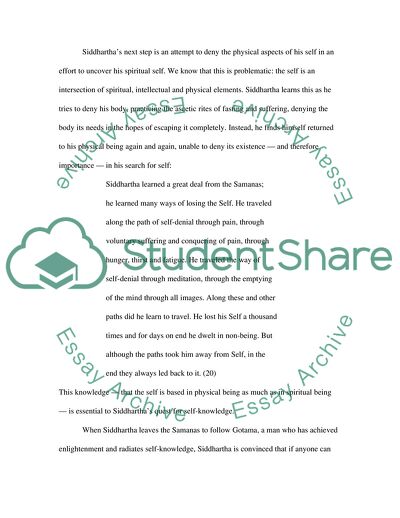
- Home
- Free Samples
- Premium Essays
- Editing Services
- Extra Tools
- Essay Writing Help
- About Us
- Studentshare
- Subjects
- Miscellaneous
- Explore the theme of the search for identity in Hesse's Siddhartha
Explore the theme of the search for identity in Hesse's Siddhartha - Essay Example

- Subject: Miscellaneous
- Type: Essay
- Level: Masters
- Pages: 4 (1000 words)
- Downloads: 0
- Author: jarvis75
Extract of sample "Explore the theme of the search for identity in Hesse's Siddhartha"
In this essay, we’ll consider the ways in which Siddhartha develops his sense of self over the course of the novel. When the novel begins, Siddhartha, tellingly, is described in terms of how other characters in the novel see him: his father sees him “growing up to become a great wise man;” his mother views him as “strong and handsome;” the eligible girls of the town note his “luminous forehead with the eye of a king.” (3) In a sense, his identity has been shaped for him, written by the eyes of the people around him.
Even when his heart is pulled in another direction and he yearns to find himself by following a local tribe of ascetics (called the Samanas), he is unwilling to do so without his father’s permission. “Siddhartha has always obeyed his father,” he says (4), waiting for his father’s leave to go, indicating that Siddhartha’s father, not Siddhartha, is the author of Siddhartha’s story. Siddhartha’s next step is an attempt to deny the physical aspects of his self in an effort to uncover his spiritual self.
We know that this is problematic: the self is an intersection of spiritual, intellectual and physical elements. Siddhartha learns this as he tries to deny his body, practicing the ascetic rites of fasting and suffering, denying the body its needs in the hopes of escaping it completely. Instead, he finds himself returned to his physical being again and again, unable to deny its existence — and therefore importance — in his search for self: When Siddhartha leaves the Samanas to follow Gotama, a man who has achieved enlightenment and radiates self-knowledge, Siddhartha is convinced that if anyone can show him the way to self-knowledge, it’s someone who has achieved it.
What Siddhartha comes to realize, however, is that there is no formula for enlightenment. Gotama had no teacher because true enlightenment is not something that can be taught; self-knowledge is not gained
...Download file to see next pages Read MoreCHECK THESE SAMPLES OF Explore the theme of the search for identity in Hesse's Siddhartha
Siddhartha is by Herman Hesse
A Soul Searcher's Handbook - Hesse's Siddhartha
Siddhartha by Hermann Hermann Hesse
Siddharta by Hermann Hesse
Comparing Siddhartha and the Temple of the Golden Pavilion
Trace Siddhartha's Changes in the Novel Siddhartha
Siddhartha: Search for Truth
Siddharthas Growth through Prostitution

- TERMS & CONDITIONS
- PRIVACY POLICY
- COOKIES POLICY